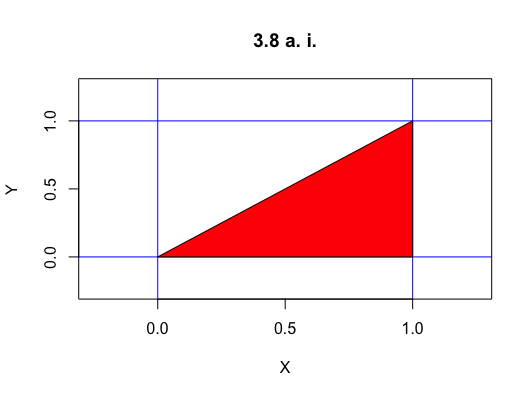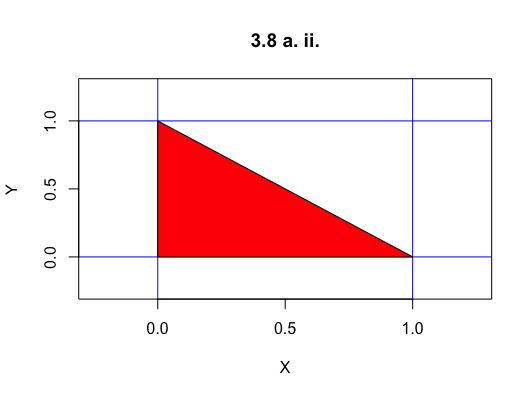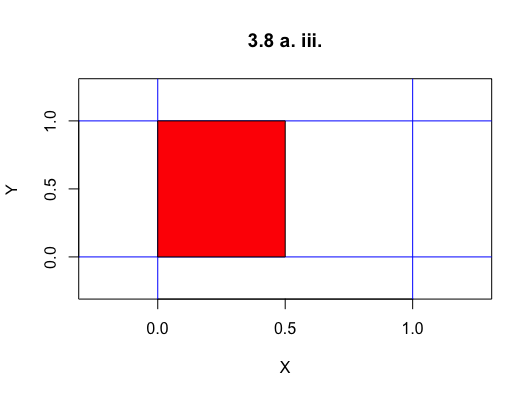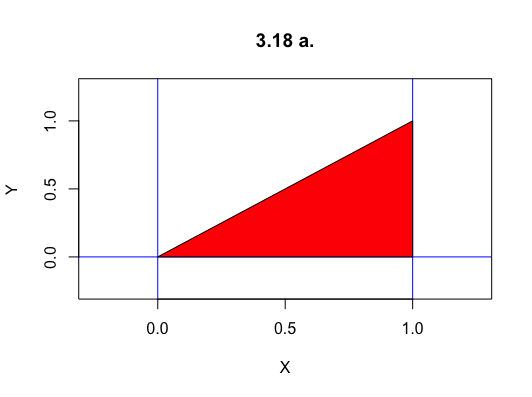Example Problems on Joint Distributions
ST501 Homework 6 on Joint Distributions
Problems: 3.7, 3.8 - Just set up the integrals, no need to solve them out, 3.14, 3.18, 3.27, 4.25, 4.44, 4.48, 4.50, 4.55, 4.56
3.7
Find the joint and marginal densities corresponding to the cdf
\[\begin{align} F(x,y) = (1-e^{-\alpha x}) (1-e^{-\beta y}), & & x \geq 0, y \geq 0, \alpha > 0, \beta > 0. \end{align}\]Multiplying gives
\[\begin{align} F_{X,Y}(x,y) & = 1 - e^{-\beta y} - e^{-\alpha x} + e^{-\alpha x + -\beta y}. \end{align}\]The joint PDF is
\[\begin{align} f_{X,Y}(x,y) & = \frac{\partial ^2 F_{X,Y}}{\partial x \partial y} \\ & = \frac{\partial}{\partial x} \Big( 0 - (-\beta) e^{-\beta y} - 0 + (-\beta) e^{-\alpha x + -\beta y} \Big) \\ & = (-\alpha) (-\beta) e^{-\alpha x + -\beta y} \\ & = \alpha \beta e^{-\alpha x + -\beta y}. \end{align}\]The marginal distribution of $Y$ is
\[\begin{align} f_Y(y) & = \int_{0}^{\infty} \alpha \beta e^{-\alpha x + -\beta y} dx \\ & = \beta e^{-\beta y}. \end{align}\]The marginal distribution of $X$ is
\[\begin{align} f_X(x) & = \int_{0}^{\infty} \alpha \beta e^{-\alpha x + -\beta y} dy \\ & = \alpha e^{-\alpha x}. \end{align}\]3.8
Let $X$ and $Y$ have the joint density
\[\begin{align} f(x,y)=\frac{6}{7}(x+y)^2, & 0 \leq x \leq 1, & 0 \leq y \leq 1 \end{align}\]a.
By integrating over the appropriate regions, find
i.
$P(X>Y)$

ii.
$P(X+Y \leq 1)$

iii.
$P(X\leq \frac{1}{2})$

b.
Find the marginal densities of $X$ and $Y$.
\[\begin{align} f_Y(y) &= \int_{0}^{1} \frac{6}{7}(x+y)^2 dx \\ f_X(x) & = \int_{0}^{1} \frac{6}{7}(x+y)^2 dy \end{align}\]c.
Find the two conditional densities.
\[\begin{align} f_{X|Y} & = \frac{\frac{6}{7}(x+y)^2}{\int_{0}^{1} \frac{6}{7}(x+y)^2 dx} \\ f_{Y|X} & = \frac{\frac{6}{7}(x+y)^2}{\int_{0}^{1} \frac{6}{7}(x+y)^2 dy} \end{align}\]3.14
Suppose that
\[\begin{align} f_{X,Y}(x,y) = x e^{-x(y+1)}, & & 0\leq x < \infty & 0\leq y < \infty \end{align}\]a.
Find the marginal densities of $X$ and $Y$. Are $X$ and $Y$ independent?
The $X$ marginal distribution is
\[\begin{align} f_X(x) & = \int_{0}^{\infty} x e^{-x(y+1)} dy \\ & = x \cdot e^{-x} \int_{0}^{\infty} e^{-xy} dy \\ & = x \cdot e^{-x} \Big[-\frac{1}{x} e^{-xy}\Big]_{0}^{infty} \\ & = x \cdot e^{-x} \Big[ -\frac{1}{x} \cdot 0 - -\frac{1}{x} \Big] \\ & = e^{-x}. \end{align}\]The $Y$ marginal distribution is
\[\begin{align} f_Y(y) & = \int_{0}^{\infty} x e^{-x(y+1)} dx \\ & = \frac{1}{(1+y)^2}. \end{align}\]We can multiply them together to check if they are independent. If their product is equal to the joint distribution, then they are independent. Otherwise they are not.
\[\begin{align} f_X \cdot f_Y & = e^{-x} \cdot \frac{1}{(1+y)^2}\\ & \neq x e^{-x(y+1)} \\ & \neq f_{X,Y}(x,y) \end{align}\]Thus, $X$ and $Y$ are not independent.
b.
Find the conditional densities of $X$ and $Y$.
The conditional density of $X$ is
\[\begin{align} f_{X|Y}(x|y) & = \frac{x e^{-x(y+1)}}{\frac{1}{(1+y)^2}} \\ & = x(y+1)^2 \cdot e^{-x(y+1)}. \end{align}\]The conditional density of $Y$ is
\[\begin{align} f_{Y|X}(y|x) & = \frac{x e^{-x(y+1)}}{e^{-x}} \\ & = x \cdot e^{-xy}. \end{align}\]3.18
Let $X$ and $Y$ have the joint density function
\[\begin{align} f(x,y) = k(x-y), & & 0 \leq y \leq x \leq 1 \end{align}\]and 0 elsewhere.
a.
Sketch the region over which the density is positive and use it in determining limits of integration to answer the following questions.

b.
Find $k$.
Since $f_{X,Y}(x,y)$ is a PDF, we know that integrating over the whole area will give $1$. So,
\[\begin{align} 1 & = \int_{0}^{1} \int_{0}{x} k(x-y) dy dx \\ & = k \int_{0}^{1} \int_{0}{x} (x-y) dy dx \\ & = k \int_{0}^{1} \Big[ xy - \frac{1}{2} y^2 \Big]_{0}^{x} dx \\ & = k \int_{0}^{1} (x^2 - \frac{1}{2} x^2) dx \\ & = k \cdot \frac{1}{6} \\ k & = 6. \end{align}\]c.
Find the marginal densities of $X$ and $Y$.
The marginal distribution of $X$ is
\[\begin{align} f_X(x) & = \int_{0}^{x} 6x - 6y dy \\ & = 6 x y - 3 y^2 |_{0}^{x} \\ & = 6 x^2 - 3x^2 \\ & = 3x^2. \end{align}\]The marginal distribution of $Y$ is
\[\begin{align} f_Y(y) & = \int_{0}^{1} 6x - 6y dx \\ & = 3x^2 - 6xy |_{0}^{1} \\ & = 3 - 6y. \end{align}\]d.
Find the conditional densities of $Y$ given $X$ and $X$ given $Y$.
The conditional density of $X$ is
\[\begin{align} f_{X|Y} & = \frac{6x - 6y}{3-6y} \\ & = 3 \Big( \frac{2(x-y)}{1-y} \Big). \end{align}\]The conditional density of $Y$ is
\[\begin{align} f_{Y|X} & = \frac{6x - 6y}{3x^2} \\ & = 3 \Big( \frac{2(x-y)}{x^2} \Big). \end{align}\]3.27
Prove that $X$ and $Y$ are independent if and only if $f_{X|Y}(x|y)=f_X(x)$ for all $x$ and $y$.
We must prove both the forward implication, $X$ and $Y$ are independent if $f_{X|Y}(x|y)=f_X(x)$ for all $x$ and $y$, and the backwards implication, $f_{X|Y}(x|y)=f_X(x)$ for all $x$ and $y$ if $X$ and $Y$ are independent.
Proof of forward
If $X \perp Y$ then $f_{X,Y}(x,y) = f_X \cdot f_Y$. So,
\[\begin{align} f_{X|Y}(x,y) & = \frac{f_(X,Y)}{f_Y} \\ & = \frac{f_X \cdot f_Y}{f_Y} \\ & = f_X. \end{align}\]Proof of backward
If $f_{X|Y}(x|y) = f_X(x)$, then
\[\begin{align} f_X(x) & = \frac{f_{X,Y}(x,y)}{f_Y(y)}\\ f_X(x) \cdot f_Y(y) & = f_{X,Y}(x,y) \end{align}\]Thus, $X$ and $Y$ are independent.
4.25
If $X_1$ and $X_2$ are independent random variables following a gamma distribution with parameters $\alpha$ and $\lambda$, find $E(R^2)$, where $R^2=X_1^2+X_2^2$.
\[\begin{align} E(R^2) & = E(X_1^2 + X_2^2) \\ & = E(X_1^2) + E(X_2^2) & \text{by } \perp \\ & = (Var(X_1) + E(X_1)^2 ) + (Var(X_2) + E(X_2)^2 ) \\ & = \Big(\frac{\alpha}{\lambda^2} + \Big(\frac{\alpha}{\lambda}\Big)^2 \Big) + \Big(\frac{\alpha}{\lambda^2} + \Big(\frac{\alpha}{\lambda}\Big)^2 \Big) \\ & = 2 \alpha \Big( \frac{1+\alpha}{\lambda^2} \Big) \end{align}\]4.44
If $X$ and $Y$ are independent random variables with equal variances, find $Cov(X+Y, X-Y)$.
\[\begin{align} Cov(X+Y, X-Y) & = E((X+Y)(X_Y)) - E(X+Y)E(X-Y) \\ & = E(X^2-Y^2) - E(X+Y)E(X-Y) \\ & = E(X^2) - E(Y^2) - E(X+Y)E(X-Y) & \text{by } \perp \\ & = E(X^2) - E(Y^2) - (E(X) + E(Y)) (E(X) - E(Y)) & \text{by } \perp \\ & = E(X^2) - E(Y^2) - E(X)^2 + E(Y^2) \\ & = \Big[ E(X^2) - E(X)^2 \Big] - \Big[ E(Y^2) - E(Y)^2 \Big] \\ & = Var(X) - Var(Y) \\ & = 0 \end{align}\]4.48
Let $U$ and $V$ be independent random varaibles with means $\mu$ and variances $\sigma^2$. Let $Z = \alpha U + V \sqrt{1-\alpha^2}$. Find $E(Z)$ and $\rho_{UZ}$.
To find $E(Z)$ we can use properties of independent variables.
\[\begin{align} E(Z) = E(\alpha U + V\sqrt{1-\alpha^2}) & = E(\alpha U) + E(V\sqrt{1-\alpha^2}) & \text{by } \perp \\ & = \alpha E(U) + \sqrt{1-\alpha^2} E(V) \\ & = \alpha \mu + \sqrt{1-\alpha^2} \cdot \mu \\ & = \mu \Big(\alpha + \sqrt{1-\alpha^2}\Big) \end{align}\]To find $\rho_{UZ} = \frac{Cov(U, Z)}{\sqrt{Var(U)\cdot Var(Z)}}$, we need to find $Cov(U, Z)$ and $Var(Z)$.
\[\begin{align} Cov(U, Z) & = E(UZ) - E(U)E(Z) \\ & = E\Big(U\Big(\alpha U + V \sqrt{1-\alpha^2}\Big)\Big) - \mu \cdot \mu \Big(\alpha + \sqrt{1-\alpha^2}\Big) \\ & = E\Big(\alpha U^2 + U\cdot V \sqrt{1-\alpha^2}\Big) - \mu^2 \Big(\alpha + \sqrt{1-\alpha^2}\Big) \\ & = \alpha E(U^2) + \sqrt{1-\alpha^2} E(U) E(V) - \mu^2 \Big(\alpha + \sqrt{1-\alpha^2}\Big) & \text{by } \perp \\ & = \alpha (Var(U) + E(U)^2) + \sqrt{1-\alpha^2} \cdot \mu^2 - \mu^2 \alpha - \mu^2 \cdot \sqrt{1-\alpha^2}\Big) \\ & = \alpha (\sigma^2 + \mu^2) - \mu^2 \alpha \\ & = \alpha \cdot \sigma ^2 + \alpha \cdot \mu ^2 - \mu^2 \alpha \\ & = \alpha \cdot \sigma^2 \\ Var(Z) & = E(Z^2) - E(Z)^2 \\ & = E\Big(\Big(\alpha U + \sqrt{1-\alpha^2} V\Big)^2\Big) - \mu^2\Big( \alpha + \sqrt{1-\alpha^2} \Big)^2 \\ & = E\Big( \alpha^2 U^2 + 2 \alpha \sqrt{1-\alpha^2} U V + (1-\alpha ^2) V \Big) - \mu^2\Big( \alpha + \sqrt{1-\alpha^2} \Big)^2 \\ & = \alpha^2 E(U^2) + 2\alpha \sqrt{1-\alpha^2} E(U) E(V) + (1-\alpha ^2 E(V) - \mu^2\Big( \alpha + \sqrt{1-\alpha^2} \Big)^2 & \text{by } \perp \\ & = \alpha^2 (\sigma^2 + \mu^2) + 2 \alpha \sqrt{1-\alpha ^2} \mu^2 + (1-\alpha^2)(\sigma^2 + \mu^2) - \mu^2\Big( \alpha + \sqrt{1-\alpha^2} \Big)^2 \\ & = \sigma^2 \end{align}\]Thus,
\[\begin{align} \rho_{UZ} & = \frac{Cov(U, Z)}{\sqrt{Var(U)\cdot Var(Z)}}\\ & = \frac{\alpha \sigma^2}{\sqrt{\sigma^2 \sigma ^2})} \\ & = \alpha. \end{align}\]4.50
Suppose that $X_i$ wehre $i = 1, \dots, n$ and independent random variables with $E(X_i)=\mu$ and $Var(X_i)=\sigma^2$. Let $\bar{X}=n^{-1}\sum_{i=1}^{n}X_i$. Show that $E(\bar{X}) = \mu$ and $Var(\bar{X})=\sigma^2/n$.
\[\begin{align} E(\bar{X}) & = E\Big(\frac{1}{n} \sum_{i=1}^{n}X_i\Big) \\ & = \frac{1}{n} E\Big( \sum_{i=1}^{n}X_i\Big)\\ & = \frac{1}{n} (E(X_1) + E(X_2) + \dots + E(X_n)) & \text{by } \perp \\ & = \frac{1}{n} (\mu + \mu + \dots + \mu ) \\ & = \frac{1}{n} \cdot n \cdot \mu \\ & = \mu \\ Var(\bar{X}) & = Var\Big(\frac{1}{n} \sum_{i=1}^{n}X_i\Big) \\ & = \frac{1}{n^2} \Big( \sum_{i=1}^{n}X_i\Big) \\ & = \frac{1}{n^2} \Big[ Var(X_1) + Var(X_2) \dots + Var(X_n) + \sum_{i=1}^{n-1} \sum_{j>i}^{n} Cov(X_i, X_j) \Big] \\ & = \frac{1}{n^2} \Big[ Var(X_1) + Var(X_2) \dots + Var(X_n) + 0 \Big] & \text{by } \perp \\\ & = \frac{1}{n^2} (\sigma^2 + \sigma^2 + \dots \sigma^2) \\ & = \frac{1}{n^2} \cdot n \sigma^2 \\ & = \frac{\sigma^2}{n} \end{align}\]4.55
Let $T=\sum_{k=1}^{n}kX_{k}$ where the $X_{k}$ are independent random variables with means $\mu$ and variances $\sigma^2$. Find $E(T)$ and $Var(T)$.
\[\begin{align} E(T) & = E\Big(\sum_{k=1}^{n} X_k\Big) \\ & = E(1 \cdot X_1) + E(2 \cdot X_2) + \dots + E(n \cdot X_n) & \text{by } \perp & = 1 E(X_1) + 2 E(X_2) + \dots + n E(X_n) \\ & = 1 \mu + 2 \mu + \dots n \mu \\ & = \frac{n(n+1)}{2} \mu \\ Var(T) & = Var\Big(\sum_{k=1}^{n} X_k\Big) \\ & = Var(1 \cdot X_1) + Var(2 \cdot X_2) + \dots + Var(n \cdot X_n) + \\ & = 1^2 Var(X_1) + 2^2 Var(X_2) + \dots + n^2 Var(X_n) + \sum_{i=1}^{n-2} \sum_{j>i}^{n} Cov(X_i, X_j)\\ & = 1^2 Var(X_1) + 2^2 Var(X_2) + \dots + n^2 Var(X_n) & \text{by } \perp \\ & = 1^2 \sigma ^2 + 2^2 \sigma ^2 + \dots n^2 \sigma ^2 \\ & = \frac{n(n+1)(2n+1)}{6} \sigma^2 \end{align}\]4.56
Let $S=\sum_{k=1}^{n}X_{k}$ where $X_{k}$ are as in Problem 55. Find the covariance and the correlation of $S$ and $T$.
To find $Corr(S,T) = \frac{Cov(S,T)}{\sqrt{Var(S)Var(T)}}$, we need to find $Cov(S,T) = E(ST) - E(S)E(T)$. Thus, we will also need to find $E(S)$, $Var(S)$, and $E(ST)$.
\[\begin{align} E(S) & = E\Big( \sum_{i=1}^{n} X_i \Big) \\ & = E(X_1) + E(X_2) + \dots E(X_n) & \text{by } \perp \\ & = \mu + \mu + \dots + \mu \\ & = n \cdot \mu \end{align}\] \[\begin{align} Var(S) & = Var\Big( \sum_{i=1}^{n} X_i \Big) \\ & = Var( X_1 ) + \dots + Var( X_n ) + \sum_{i=1}^{n-1} \sum_{j>i}^{n} Cov(X_i, X_j) \\ & = \sigma^2 + \dots + \sigma^2 + 0 & \text{by } \perp \\ & = n \cdot \sigma^2 \end{align}\] \[\begin{align} Cov(S,T) & = E(ST) - E(S)E(T) \\ & = E \Big(\sum_{k=1}^{n} \sum_{i=1}^{n} X_k \cdot i \cdot X_i \Big) + E\Big(\sum_{k=1}^{n} X_k\Big) \cdot E\Big(\sum_{i=1}^{n} i \cdot X_i \Big) \\ & = \sum_{k=1}^{n} \sum_{i=1}^{n} i \cdot E (X_k \cdot X_i ) + \sum_{k=1}^{n} E( X_k) \cdot \sum_{i=1}^{n} i \cdot E( X_i) \\ & = \sum_{k=1}^{n} \sum_{i=i}^{n} i \Big[ E (X_k \cdot X_i ) + E( X_k) \cdot E( X_i) \Big] \end{align}\]Notice that the part inside the brackets is $Cov(X_k, X_i)$. Since each $X_j$ is independent, every term with $k \neq i$ is $0$. Also, any term with $k = i$ is $\sigma^2$ because $Cov(X_i, X_i) = \sigma^2$. Thus,
\[\begin{align} Cov(S, T) & = 1 \cdot \sigma^2 + 2 \cdot \sigma^2 + \dots + n \cdot \sigma^2 \\ & = \frac{n(n+1)}{2} \cdot \sigma^2. \end{align}\]Thus,
\[\begin{align} Corr(S, T) & = \frac{Cov(S,T)}{\sqrt{Var(S)Var(T)}} \\ & = \frac{\frac{n(n+1)}{2} \cdot \sigma^2}{\sqrt{ n \cdot \sigma^2 \cdot \frac{n(n+1)(2n+1)}{6} \sigma^2}} \\ & = \frac{\frac{n+1}{2}}{\sqrt{\frac{n(n+1)(2n+1)}{6}}}. \end{align}\]![=]](/img/smile.svg)